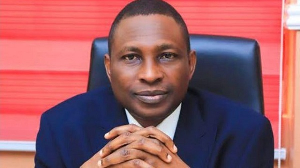- Home - News
- TWI News | TV
- Polls
- Year In Review
- News Archive
- Crime & Punishment
- Politics
- Regional
- Editorial
- Health
- Ghanaians Abroad
- Tabloid
- Africa
- Religion
- Election 2020
- Coronavirus
- News Videos | TV
- Photo Archives
- News Headlines
- Press Release
General News of Thursday, 27 July 2006
Source: Statsman
Does Ghana need a Museum of Science & Tech?
The canker of successive governments’ failure to continuing projects initiated by their predecessors has robbed Ghana of a worthwhile culture of adequately keeping track of our exploits in various fields of development, including physical structures and projects.
This problem has also left in its trail, a huge number of otherwise laudable projects abandoned.
One such project is the Museum of Science and Technology in Accra, which has become a white elephant, staring at Ghanaians visiting the place from various points.
In our effort to promote National consciousness and economic developments, The Statesman has researched into the significance and importance of Museums in general and the Museum of Science and Technology in Ghana specifically.
According to the definition by the International Council of Museums, a museum is typically a permanent institution in the services of society and of its development, open to the public, which acquires, conserves, research, communicates and exhibits, for purposes of study, education, enjoyment, the tangible and intangible evidence of people and their environment.
The word museum is a Latin word; its plural form is musea. It is derived from the Greek word mouseion, which refers to a place or temple dedicated to the Muses (the patron divinities in Greek mythology of the arts), and hence a building set apart for study, especially the institute for philosophy and research at the Library established at Alexandria by Ptolemy I Soter c280 BC. Modern museum trends in museology have broadened the range of subject matter and introduced many interactive exhibits, which give the public the opportunity to make choices and engage in activities that may vary the experience from person to person. It is said that there are more museums per person in Finland than any other country in the world.
Modern museums generally concentrate on a particular subject, and most museums belong to one or more of the following categories: fine arts, applied arts, craft, archaeology, anthropology and ethnology. Others are cultural history, military history, science and technology, natural history and numismatics. Back home in Ghana, the Museum of Science and Technology, formerly called Ghana National Science Museum, was established in August 1965. It was the brain child of Alan M May and Wright, both, then lecturers at the University of Ghana, Legon.
They mooted the idea of MST to the then President of Ghana Kwame Nkrumah. These eminent professors also presented a copy of their proposal to the Ghana Academy of Arts and Science.
In 1963, an expert and Deputy Keeper of the Department of Chemistry from the British Museum, Dr Frank Greenaway was invited to the country to undertake a feasibility study of the proposed MST.
The objective for the establishment of the MST was to acquire and preserve achievements in science and technology both past and present. It was to ensure that skills and appropriate technology are effectively demonstrated and transferred to the entire public at large. It was also to show the application of science and technology in industry and human welfare.
Another purpose for the establishment of the MST in the country was to stimulate interest in science and technology, so that in future, more Ghanaians, especially the youth, may be attracted to science and technology. However, 41 years down the lane, nothing has been achieved as far as the purpose of the establishment of the MST is concerned. The building, until recently, was being occupied by squatters.
In an interview with The Statesman on the state of affairs at the museum, Agyiri Sackey, Principal Curator of the MST, said, in the modern world, science and technology is the driving force behind everything. He said the difference between a developed country and a developing one is determined by the level of appreciation and application of science and technology in their day to day life. He said the MST was intended to serve as a link between industry, research centres and the public. He noted that if the MST had lived up to its expectations, the country’s technological advancement would have been fast tracked.
He explained that the lack of interest in science at our schools would have been a thing of the past had the MST been completed to play its functions, because one of the objectives of the establishment of the MST is to demystify science, and make it more appealing to the ordinary Ghanaian. “The libraries in the museum were intended to contain books on the achievements and life history of great scientists and researchers like Einstein and Newton, that will inspire and motivate students and all who visit it to learn science,” he explained.
He disclosed that Government recently released ¢2.5bn to be used in the completion of the project. He added that the idea now is to complete the ground floor of the building housing the MST for the staff to move in; the rest of the work could then continue.
Mr Sackey said the major challenges facing the MST now, are lack of human resources, and logistics. He said the few personnel with the MST are also resigning due to the poor condition of service and a lack of resources to work with.
He appealed to Government to place the MST under the Ministry of Education, Science and Sports, because of its link to education. He also called for more attention to be paid to museums in general, and the MST in particular to stimulate interest in the study of science.










